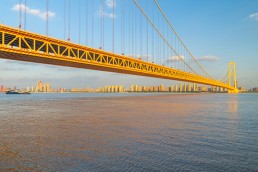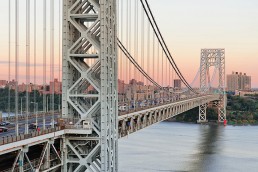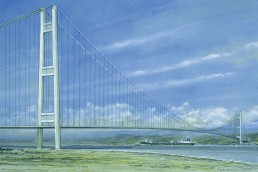Grand Pont Suspendu
© Pechristener, Wikimedia CommonsGrand Pont Suspendu 1834
Grand Pont Suspendu 1834
The Bridge
The Grand Pont Suspendu, at Fribourg in Switzerland, was built in 1834 and removed in 1923. It is fitting that this bridge is included in a collection of the world’s greatest suspension bridges because Joseph Chaley’s design is historically important in setting a new standard. He was inspired by French engineer Louis Vicat to develop the use of main suspension cables. At Fribourg the four main cables were made up of over 1,000 individual wires and ‘spun’ on site. This enabled the construction of long cables at less cost than previous methods and achieved a world record clear span of 273m.
This method has become known as aerial spinning. John A Roebling developed it further for use on the Brooklyn Bridge, and Bill Brown consulted on projects throughout the world with his cable erection refinements cutting construction time and saving project costs.
Grand Pont Suspendu
Historically-important span in Fribourg
Key Facts
Opened in 1834 and removed in 1923
Joseph Chaley’s design pioneered the use of individual wires ‘spun’ on site to form the main suspension cables
Location
Fribourg, Switzerland
Crossed the Sarine River until 1923
Designers / Engineers
Joseph Chaley
Description
Suspension bridge
273m main span
Challenge
To develop the four main cables each from 1,056 individual iron wires
Construction
Began in 1832
Opened in 1834
Removed in 1923
Other long-span bridges
Çanakkale Dardanelles
© ÇOK ASÇanakkale Dardanelles Bridge 2023
Çanakkale Dardanelles Bridge 2023
© B2 Archive
World Record Longest Bridge Spans
There is a new world record for the longest main-span suspension bridge. After decades of planning and four years of construction the 1915 Canakkale Bridge over the Dardanelles Strait in north west Turkey has opened for traffic. At 2,023m main span it succeeds the Akashi-Kaikyo Bridge in Japan and is a glorious celebration of the development of Turkey.
The official opening in 2023 marked the 100th anniversary of the founding of the Republic of Turkey. It was also the 50th anniversary of the opening of the Bosphorus Bridge (18th July Martyrs’ Bridge) in Istanbul, the first bridge to link Europe and Asia.
If someone asks you: What is the world’s longest span bridge? You can say: “the 1915 Canakkale Bridge over the Dardanelles Strait”.
Bill's Proposed Bridge Design
Bill Brown first designed a bridge over the Dardanelles at Çanakkale nearly 30 years ago (B2 illustration shown above) and he would be overjoyed that his invention of the twin-box girder deck design would become a reality on the new bridge.
Bill and his firm Brown Beech were formally commissioned to prepare designs for The Dardanelles Bridge project following the success of the Second Bosphorus Bridge (Fatih Sultan Mehmet Bridge) and the expansion of the major road system. KGM recognised the need for bridges over the Dardanelles Strait and the Izmit Bay to improve communication and connect communities across Turkey.
In the early 1990s Bill and his team of consulting engineers and bridge designers at B2 were developing innovative designs with aerodynamic-box deck sections that continued the work that began with his Severn Bridge and Bosphorus Bridge designs. His introduction of the world’s-first concept of the twin-box deck (and multi-box) was the key.
Çanakkale Dardanelles Bridge
World record span suspension bridge under construction in Turkey
Key Facts
1915Çanakkale Bridge (official name)
World’s longest suspension bridge
Part of a new motorway easing the traffic load on Istanbul
Location
Near Gallipoli, North-west Turkey
Across the Dardanelles Strait
Linking Sütlüce, in Europe and Lapseki on the Asian side
Designers / Engineers
Parsons, Takfen and COWI (detailed design)
Original design concept by Dr William (Bill) Brown, B2
Mott MacDonald (Technical advisor)
Description
Steel suspension bridge
2,023m main span
3,563m total length + 1045m of approach viaducts
Main contractors
A Turkish-Korean joint venture
Comprising: Limak and Yapi Merkezi (Turkey)
Daelim and SK Engineering (Korea)
Web Links
Construction of the 1915Çanakkale Bridge
The bridge is 10km south of the town of Gallipoli in north west Turkey. Not only is it the longest central-span suspension bridge in the world at 2,023m, it also has the highest towers for a suspension bridge at 334m. The aerodynamic twin-box girder deck is 45m wide.
The towers have been built on piers in the Dardanelles Strait which is approximately four kilometres wide at this point. The cable spinning was by the controlled-tension method and the deck was erected by lifting individual sections up from a barge on the waterway.
The bridge forms part of an 88km three-lane motorway project that connects to a route west of the Sea of Marmara, opening up communications and connecting communities in this part of Turkey and easing the traffic load on Istanbul.
These images show the 3D renders of the bridge and construction videos courtesy of Çanakkale Motorway Bridge Construction Investment Management Inc. (Çanakkale Otoyol ve Köprüsü İnşaat Yatırım ve İşletme A.Ş) and ©ÇOK AŞ
© ÇOK AS
Long-span bridges in Turkey
Tinsley Viaduct
© B2 ArchiveTinsley Viaduct 1968
Tinsley Viaduct 1968
The Bridge
The two-level Tinsley Viaduct carries the M1 motorway and a main road over the heavily developed Don Valley. It was the first steel structure in Britain to have road traffic on two levels.
The 1,036m long viaduct has the six-lane M1 motorway on the top deck, with the four-lane A631 road and services (gas, electricity and water) on the lower deck.
The decks are of continuous composite construction. A prestressed reinforced concrete slab 215mm thick is supported by two main longitudinal steel box girders, with transverse cross girders and cantilevers at approximately 3m centres. The structural steel has an especially high anti-corrosion specification.
Tinsley Viaduct
A two-level box girder viaduct
Key Facts
Two-tier road bridge
Carries the M1 motorway on the upper deck
Industry continued unabated during the construction period
Location
Sheffield, England
Across the River Don
Consulting Engineers
Freeman Fox & Partners
Description
Twin-deck box girder bridge
1,036m total length
Main contractors
Cleveland Bridge & Engineering Company
Construction
Began in 1965
Lower deck opened 25 March 1968
Upper deck opened 19 October 1968
The first two-deck steel viaduct
Dr William Brown was Principal Designer at Freeman Fox & Partners in the 1960s.
One of the bridge projects he worked on with the design team was the Tinsley Viaduct with 20 simply-supported spans up to 49.7m long, and two end spans. The spans over the Don Valley are carried on 17 pairs of high tensile steel box columns. Each has a rocker support to accommodate thermal movement and subsidence, with a jacking facility to rectify any settlement. The 17 piers and four abutments are of reinforced concrete, founded at depths of 4.6 to 9.1m.
Other long-span bridges
Tsing Lung Bridge
© Ryan McManimieTsing Lung Bridge Proposed
Tsing Lung Bridge Proposed
The Bridge
The Tsing Lung Bridge was designed and planned between 1999 and 2002 to provide a second road link to Lantau Island in Hong Kong and the International Airport at Chek Lap Kok. A suspension bridge with a steel superstructure was proposed with a main span of 1418 metres. Each side spans would be 220m long.
Bill Brown and B2 worked in an engineering team for the review, design and proposed bridge construction with Chodai of Tokyo and Maunsell of Hong Kong. Bill was tasked with preparing the essential design drawings and continued his design development of the twin-box deck and undertook extensive wind tunnel testing. He created an advanced shallow streamlined deck to carry a three-lane highway for the Hong Kong Highways Department. The bridge was originally planned for completion in 2008 but has yet to be constructed.
Derivatives of Bill’s twin-box bridge deck design have subsequently been used on other bridges in China. He attempted to patent his designs and continued design protection up until his passing in 2005.
Tsing Lung Bridge
Proposed bridge to Lantau Island in Hong Kong
Key Facts
A proposed suspension bridge with a twin-box deck
6-lane roadway
Location
North Lantau to Tsing Lung Tau, Hong Kong
Across the Ma Wan Channel
Designers / Engineers
Bill Brown, Brown Beech
Chodai
Maunsell
Description
Suspension bridge
1,418m main span
Twin-box vented bridge deck

Other long-span bridges
Java Bali Bridge
© B2 ArchiveBali Straits Crossing Proposed
Bali Straits Crossing Proposed
The Bridge
Bill Brown applied his multi-box deck innovation when he was commissioned in 1996 to submit designs for a suspension bridge spanning the Indonesian islands of Java and Bali. Bill advised that the new Bali bridge should become a dual-box suspended span of 2,100 metres. He proposed an initial two-lane deck that could go on to accommodate two further curved-bottom boxes for greater stability and a final total of six lanes. This would reduce the initial capital cost of the bridge to a minimum when traffic and toll income is lowest. As traffic volume increased, toll revenue would fund the addition of bridge capacity.
Bali Straits Crossing
Proposed bridge linking Java and Bali
Key Facts
Two traffic lanes, expandable to six lanes
Location
Across the Bali Strait, Indonesia
Linking Java and Bali
Designers / Engineers
Dr William Brown
Brown Beech & Associates
Description
Steel suspension bridge design with multi-box innovation
Planned 2,100m main span
Other long-span bridges
Russky Bridge
© Volkova NataliaRussky Bridge 2012
Russky Bridge 2012
The Bridge
The world’s longest cable-stayed bridge, with a 1,104m long central span, was opened in 2012 in time for the Asia-Pacific Economic Cooperation conference hosted by Russia on Russky Island.
Two A-shaped towers or pylons reach a height of 321m and hold 168 cable stays, the longest of which is 580m. All bridge elements are designed to withstand the huge temperature range of the Vladivostok area, of between -40 and +40°C.
Russky Bridge
World's longest-span cable-stayed suspension bridge
Key Facts
World’s longest cable-stayed bridge span
Four-lane road bridge
Location
Vladivostok, Eastern Siberia, Russia
Linking Russky Island to the Nazimov peninsula
Designer
SIC Mostovik, Valery Kurepin
Description
Cable-stayed suspension bridge
1,104m main span
3,100m total length
Main contractors
USK Most
Freyssinet
Construction
Began in 2009
Opened July 2012
Other long-span bridges
Sydney Harbour Bridge
© TotajlaSydney Harbour Bridge 1932
Sydney Harbour Bridge 1932
The Bridge
The Sydney Harbour Bridge has become one of the world’s most iconic bridges and a symbol both of Sydney and Australia. It was constructed by the British firm, Dorman Long & Co., with Sir Ralph Freeman, of Freeman Fox & Partners, carrying out the detailed design work. The initial design by John Bradfield had specified a cantilever design but advances in steelmaking enabled the redesign as a less expensive steel-arch bridge.
The bridge would have to carry the heavy loads of rail and road across the deep waters of the harbour to the new suburbs to the north. The population was growing fast and the new connection was vital to the city.
It was constructed out from each bank and connected in the middle in 1930. Its 503m central span makes it one of the longest bridges of its type in the world.
Sydney Harbour Bridge
Steel-arch bridge that has become an icon of Australia
Key Facts
Steel-arch bridge opened in 1932
Links Sydney with its suburbs to the north
Carries four railtracks and a highway
Location
Sydney, Australia
Links Dawes Point on the south with Milsons Point on the north
Across Sydney Harbour
Designer
Sir Ralph Freeman, Freeman Fox & Partners (final, detailed design)
John Bradfield (initial design)
Description
Steel-arch bridge
503m main span
1,149m total length
Main contractors
Dorman Long and Co.
Construction
Began in 1923
Opened 19 March 1932
Other long-span bridges
Széchenyi Chain Bridge
© Fazon1Széchenyi Chain Bridge 1849
Széchenyi Chain Bridge 1849
The Bridge
In the 19th century bridge building was taking advantage of new materials to produce longer spans and link cities and communities. One of the most important bridges was built In the Hungarian capital, Budapest. The River Danube divides the city and in 1849 it was bridged by a wrought iron and stone crossing designed by British engineer, William Tierney Clark.
Known as the ‘Chain Bridge’ it became a symbol of Hungary’s modern identity and the linking of east and west. In World War II its deck was blown up by retreating German troops, but it was fully restored and reopened in 1949.
Széchenyi Chain Bridge
The first permanent bridge across the Danube in Budapest
Key Facts
One of Europe’s most iconic bridges
Unites a city, a nation, and east and west
Location
Budapest, Hungary
Across the River Danube
Linking Buda and Pest
Bridge designer
William Tierney Clark
Description
Chain suspension bridge
202m main span
375m total length
Engineer for construction
Adam Clark
Construction
Began in 1840
Opened 20 November 1849
Other long-span bridges
Ironbridge
© Paul DanielsIronbridge 1781
Ironbridge 1981
The Bridge
The Iron Bridge is a world renowned symbol of the 18th century Industrial Revolution. The River Severn created a deep gorge and exposed natural resources such as coal and iron ore. It was also a key trading route but a barrier to travel across the gorge.
In March 1776 Abraham Darby III, an ironmaster working at Coalbrookdale, was commissioned to cast and build an arch bridge with a single span. It became the first to be built of metal and pioneered the use of cast iron as the preferred material for bridges constructed in the late 18th and early 19th century.
The Iron Bridge
The world's first cast-iron bridge
Key Facts
Grade I listed structure
Also known as the Coalbrookdale Bridge
Location
Coalbrookdale, Shropshire, England
Across the River Severn
Linking Broseley, Madeley and Coalbrookdale
Designers / Engineers
Abraham Darby III
Thomas Farnolls Pritchard
Description
Cast-iron arch bridge
30.63m main span
60m total length
Main contractors
Abraham Darby III
Construction
Other long-span bridges
Union Bridge
Union Bridge 1820
Union Bridge 1820
The Bridge
The Union Chain Bridge became the UK’s first vehicular suspension bridge when it connected England and Scotland with a crossing of the River Tweed in 1820. The Royal Navy officer, Captain Samuel Brown, had been developing wrought iron chains and realised their use on bridge construction.
The bridge has undergone development and renovation over the past two centuries. Cables were added in 1902 and the deck has been renewed. The bridge is currently undergoing major restoration work.
When Bill Brown delivered his ‘History of Suspension Bridge Design’ presentation to engineering conferences and audiences throughout the world he would begin with a feature on the Union Bridge.
Union Bridge
Chain suspension bridge linking England and Scotland
Key Facts
Wrought iron chains used for bridge suspension
Much cheaper and faster to build than a masonry bridge
Location
Horncliffe in England to Fishwick in Scotland
Across the River Tweed
Designer
Captain Samuel Brown
Description
Chain suspension bridge
110m main span
137m total length
Main contractors
Captain Samuel Brown (chains and deck)
John Rennie (masonry towers)
Construction
Began in August 1819
Opened July 1820



















































































